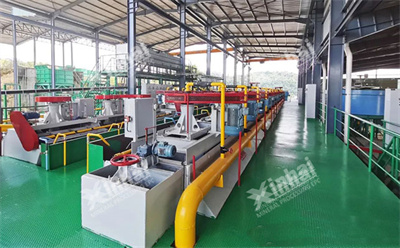Phosphate is an important chemical raw material, which is widely used in agriculture, industry, medicine, food and other industries, especially as a raw material for making phosphate fertilizer. However, with the depletion of high-grade phosphate resources, the grade of phosphate ores mined now is relatively low, and it may be difficult to achieve the ideal beneficiation index with a simple single beneficiation process. At this time, it is necessary to understand the beneficiation method for low-grade phosphate ores in order to choose a more suitable solution.
Flotation is one of the most widely used low-grade phosphate ore beneficiation technologies. The working principle of flotation is to separate the useful minerals from the gangue in the phosphate ore through physical and chemical methods, thereby improving the grade of the phosphate concentrate. For low-grade phosphate ore, commonly used flotation methods include direct positive flotation, single reverse flotation, positive-reverse flotation, reverse-positive flotation, double reverse flotation, etc.
(1) Direct positive flotation technology
The principle of direct positive flotation technology is to suppress gangue minerals by adding inhibitors, and then collect phosphate minerals by using collectors. This process is suitable for siliceous or calcium-siliceous phosphate rock, endogenous apatite, and sedimentary phosphate ore, especially for sedimentary phosphate ore.
(2) Reverse flotation technology
Reverse flotation is mainly aimed at phosphate ore with dolomite as the main gangue mineral. Under weakly acidic conditions, the inhibitor sodium phosphate is used to suppress phosphate minerals, and specific collectors (oleic acid and kerosene) float out dolomite. The exclusion rate of dolomite can reach 70-80%.

Gravity separation is a physical mineral separation method that uses density differences between minerals for separation. This method is simple, low-cost and suitable for pre-selection of coarse-grained phosphate rock. The gravity separation method for processing low-grade phosphate rock mainly uses mineral density differences for sorting. Commonly used reselection methods include:
(1) Heavy media separation: When processing low-grade phosphate ore, heavy media separation can effectively separate high-density phosphorus minerals and low-density gangue minerals, thereby improving the grade of phosphate ore.
(2) Jig sorting: The principle of jig is to use the pulsating flow of water to layer phosphate rock and gangue minerals according to density differences. Heavy minerals sink to the bottom, and light minerals are taken away by the water flow.
(3) Shaking table sorting: The shaking table is suitable for processing fine-grained minerals, and has a better recovery effect on fine-grained phosphorus minerals in low-grade phosphate ores.
(4) Spiral chute sorting: The spiral chute uses gravity, friction and water flow to sort minerals according to density. This method is effective in processing seashore placers and other placers containing ilmenite, rutile, zircon and monazite. In recent years, it has also been used to sort low-grade phosphate ores.
Scrubbing and desludging method is a physical beneficiation method. By scrubbing or grinding weathered phosphate ore in water, the surface mud is removed to enrich the phosphate minerals. The enrichment ratio of this method is generally not large, and it can only increase the P2O5 grade by 3 to 5 percentage points.
Chemical leaching method dissolves and separates useful minerals and gangue by chemical agents reacting with ore. This method is suitable for treating phosphate ore with high impurities such as magnesium.
Photoelectric beneficiation method is an emerging beneficiation technology that uses the photoelectric effect to separate minerals with different optical properties. This method is suitable for specific types of phosphate ore and has the advantages of simple operation and environmental protection.
The combined beneficiation method combines the advantages of the above methods and improves the beneficiation efficiency and concentrate quality of low-grade phosphate ore by optimizing process parameters and reagent system. For example, the normal temperature flotation process of "positive flotation-coarse combined reverse flotation-coarse-sweep" for medium and low-grade collophanite effectively improves the utilization rate of phosphate ore.
Combined heavy-floatation process: This is a new idea. It uses efficient water medium cyclone and short column flotation tank to achieve more economical and reasonable recovery of collophanite, improve the grade of concentrate and the removal efficiency of impurities therein.
The above introduces six beneficiation methods suitable for processing low-grade phosphate ore. It is recommended to conduct beneficiation tests before formulating the beneficiation plan, because the selection of the appropriate beneficiation method needs to be determined according to the specific properties and selectivity of the ore. Moreover, the formulation of the plan is also related to the final beneficiation index, so it is particularly important. If you have low-grade phosphate ore beneficiation needs, please contact us.